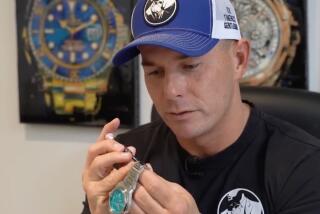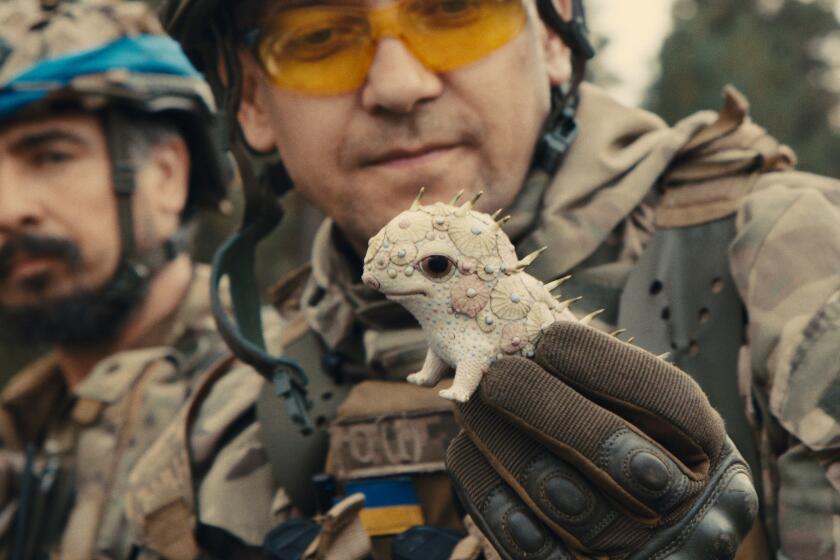Charles Farrell, 89; Film and TV Actor, Developer, Former Palm Springs Mayor
- Share via
Charles Farrell, whose patrician features placed him among the most luminescent of filmdom’s early stars and whose business acumen took him to the barren desert east of Los Angeles where he built a posh tennis club atop scrub brush, has died.
Friends said Thursday that the developer and one-time mayor of Palm Springs had died Sunday of heart failure at his Palm Springs home but had asked that news of his death not be announced until after the funeral.
He was 89 and was buried Wednesday at Welwood Murray Pioneer Cemetery in the old film colony section of Palm Springs beside his wife, actress Virginia Valli.
He and Janet Gaynor, who died in 1984, were America’s most famous film couple in the late 1920s and early ‘30s when motion pictures first found a voice. But Farrell’s popularity declined when his Boston Brahmin enunciations brought him into disfavor with the old Fox Studios front office. Tired, he said years later, of trying to portray James Cagney with an accent more like James Mason’s, he left films and--despite the forbidding Great Depression--he and actor Ralph Bellamy in 1934 built two tennis courts on sand drifts and scrub that they surrounded with a ramshackle board fence.
The endeavor proved so successful that the Charles Farrell Racquet Club was to become not only the setting for his own fortune but for a late 1950s television series that starred Farrell as the club’s owner, dealing with the minor travails of family and staff.
That was his second brush with TV stardom, his first coming in 1952 when he became known to the children of his film fans as Vernon Albright, father of the mischievous Gale Storm in “My Little Margie.”
Farrell, once known with Miss Gaynor as “America’s Favorite Lovebirds,” was born Charles David Farrell in Onset Bay, Mass., to a mother interested in acting and a father who owned restaurants and some early motion picture theaters.
Farrell graduated from Boston University, where he had intended to become a psychologist. Instead, he made a post-graduation excursion to California, where his classic features and athletic build helped him find work in films. He worked as a $3-a-day extra in the early 1920s and finally was given a minor role in “The Ten Commandments,” the 1923 Cecil B. de Mille epic.
But it was four more years of bit parts in forgotten films before he was cast opposite Miss Gaynor in “Seventh Heaven,” one of the last of the big silent picture productions. He was the Paris street cleaner, Chico, who saves a street waif, Diane, marries her but then goes off to war and returns blinded. The movie brought Miss Gaynor the first Academy Award ever given an actress and turned Farrell from a struggling actor into a star.
The “lovebirds” were to make 11 other films, including “Street Angel,” “Lucky Star” and “The Man Who Came Back” before their final teaming in 1934 in “Change of Heart.”
They were the first of Hollywood’s Golden Couples, but after 1934 Farrell’s star began to tarnish in “Fighting Youth” and “Flight to Fame,” while she went on to further triumphs in such epics as the 1937 “A Star Is Born.”
In the interim Farrell had discovered Palm Springs. Rather than fight the change in matinee idolatry that found “tough guys” Cagney, Clark Gable and Humphrey Bogart more in demand, he opted to risk his film earnings on a few acres of sand on North Indian Avenue.
“Soon,” he said in a 1968 interview, “other motion picture people, wanting privacy, started driving out from Hollywood to join us.”
Farrell and Bellamy (who sold his interest to return to the New York stage) were charging $1 to play tennis on their primitive courts. And even though Farrell remembered years later that “hardly anybody” ever paid, he was soon able to build a swimming pool, dining room and bar and cottages for overnight guests.
He also bought nearby land at $30 per acre, selling it quickly for $500 as the desert boomed.
“They helped create the glamorous place that Palm Springs is today,” said Diana Lewis Powell, wife of the late actor William Powell, who was a neighbor.
By the time he sold the Charles Farrell Racquet Club in 1959 for a reported $1.2 million, Farrell had not only become Palm Springs’ most famous and enduring resident but the city’s mayor from 1947 to 1955.
The extent of Farrell’s desert popularity was such that when his racquet club was sold again, in 1965, part of the deal was that Farrell return as club operator.
By then Farrell also had re-established himself as an actor, this time on television. His hair was now gray, as was the pencil-thin mustache that remained his insignia. But that combination, coupled with his imperious New England stance, made him a perfect foil for Miss Storm.
In the 1952-55 series, Farrell played a financially successful but authoritarian widower whom “Margie” (pronounced “Mahgie” by Farrell) tried to make more affable.
After the show went off the air, Farrell was offered “The Charlie Farrell Show” and from 1956 to 1960 portrayed himself in an almost autobiographical series based often on things that had gone on at the Racquet Club.
After that Farrell returned permanently to the desert property he had purchased years before Palm Springs was even a city, living quietly with his wife, who died in 1969.
There were his dogs, a piano he said he couldn’t play and his trophies--from his polo-playing days with Will Rogers.
There also was a photo of Farrell and Miss Gaynor on the TV set that he sat before most of the day. Most of the friends who helped him develop the desert had died years before and shopping malls had replaced many of the hotels where his film friends had gathered on weekends.
But all in all, he told The Times in 1977, “I had a helluva career.”
More to Read
Only good movies
Get the Indie Focus newsletter, Mark Olsen's weekly guide to the world of cinema.
You may occasionally receive promotional content from the Los Angeles Times.










